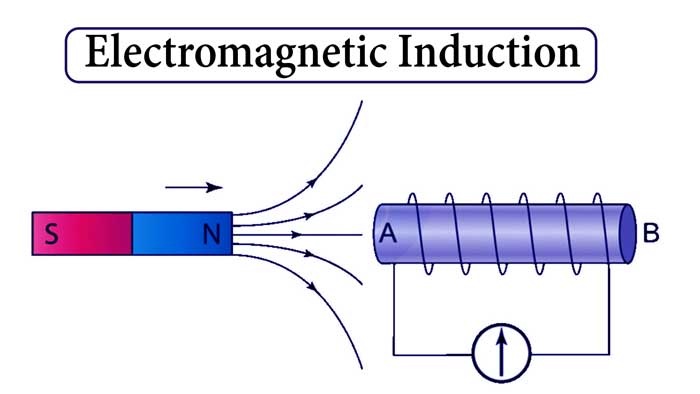Understanding Electromagnetic Induction: Principles, Applications, and Key Concepts Explained
Electromagnetic induction is a fundamental concept in electromagnetism
and is a key principle behind many electrical devices and technologies. It
describes the process by which a changing magnetic field within a closed loop
of wire induces an electromotive force (EMF) or voltage. This principle was
discovered by Michael Faraday in 1831, and it has since become a cornerstone of
modern electrical engineering and physics.
Key Concepts in Electromagnetic Induction
Faraday's Law of Electromagnetic Induction: This law states that an EMF is
induced in a closed loop when the magnetic flux through the loop changes over
time. The induced EMF is proportional to the rate of change of the magnetic
flux.
Lenz's Law: This law complements Faraday's law by describing the
direction of the induced EMF. According to Lenz's law, the induced EMF will
generate a current whose magnetic field opposes the change in magnetic flux
that caused it. This ensures conservation of energy and gives rise to phenomena
like back EMF in motors and generators.
Applications of Lenz’s law
– When a north pole of a bar magnet is moved towards a coil, the current
induced in the coil will be in an anticlockwise direction as shown in the
figure.
– When a north pole of a bar magnet is moved away from the coil, the
current induced in the coil will be in a clockwise direction as shown in the
figure.
– When a current-carrying coil is moved towards a stationary coil, the
direction of the current induced in the stationary coil is as shown in the
figure.
– When a current-carrying coil is moved away from a stationary coil, the
direction of the current induced in the stationary coil is as shown in the
figure.
– When two coils A and B are arranged as shown in the figure, then on
pressing K, current in A increases in a clockwise direction. Therefore, the
induced current in B will be in an anticlockwise direction.
– However, when key K is released, current in A decreases in a clockwise
direction. Therefore, the induced current in B will be in a clockwise
direction.
– When the current in a straight conductor AB is increased, induced
current in the loop will be in a clockwise direction as shown in the figure.
If the current in AB is decreasing, the induced current in the loop will
be in an anticlockwise direction.

Magnetic Flux: This is the measure of the total magnetic field
passing through a given area. A change in magnetic flux can be due to
variations in the magnetic field's strength, the area it encompasses, or the
angle between the field and the area.
Faraday’s law of electromagnetic induction
First law: Whenever the amount of magnetic flux linked with a circuit
changes, an emf is induced in the circuit. This induced emf persists as long as
the change in magnetic flux continues.
Second law: The magnitude of the induced emf is equal to the time rate
of change of magnetic flux. Mathematically, induced emf is given by e = − df /
dt
Where a negative sign indicates the direction of e.
Lenz’s law: This law gives us the direction of induced emf. According to
this law, the direction of induced emf in a circuit is such that it opposes the
change in magnetic flux responsible for its production. Lenz’s law is in
accordance with the principle of conservation of energy.
Fleming’s right-hand rule: Fleming’s right-hand rule also gives us the
direction of induced emf or current, in a conductor moving in a magnetic field.
According to this rule, if we stretch the forefinger, central finger and thumb
of our right hand in mutually perpendicular directions such that forefinger
points along the direction of the field and thumb is along the direction of
motion of the conductor, then the central finger would give us the direction of
induced current or emf.
Applications of Electromagnetic Induction
Electromagnetic induction has a wide range of applications in everyday
technology and industry. Here are some key examples:
Electric Generators: Generators convert mechanical energy into electrical
energy using electromagnetic induction. As a coil of wire is rotated in a
magnetic field, the changing magnetic flux induces an EMF, producing
electricity.
Electric Transformers: Transformers use electromagnetic induction to change
the voltage levels in alternating current (AC) circuits. They consist of
primary and secondary coils wrapped around a magnetic core. A changing current
in the primary coil induces a current in the secondary coil, allowing for
voltage transformation.
Induction Motors: These motors rely on electromagnetic induction to
generate torque. A rotating magnetic field induces currents in a rotor, which
creates a force that drives the motor.
Wireless Charging: Electromagnetic induction is the basis for many
wireless charging systems. A changing magnetic field from a charging pad
induces current in a nearby device, allowing for contactless energy transfer.
Relevance to Class 12 Physics
Electromagnetic induction is a key topic in Class 12 physics, often
studied as part of the broader electromagnetism curriculum. Students typically
learn about Faraday's law, Lenz's law, and applications like transformers and
generators. Understanding these concepts is crucial for both academic exams and
practical applications in electrical engineering and related fields.
